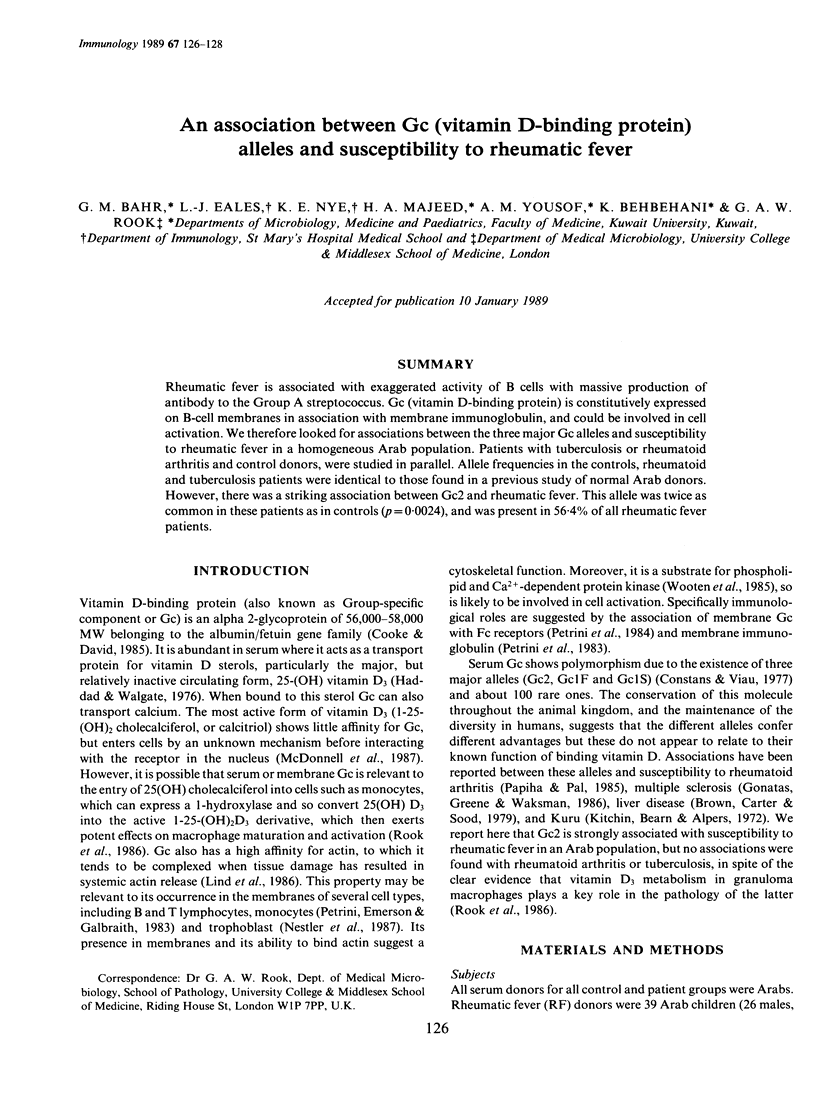Abstract
Rheumatic fever is associated with exaggerated activity of B cells with massive production of antibody to the Group A streptococcus. Gc (vitamin D-binding protein) is constitutively expressed on B-cell membranes in association with membrane immunoglobulin, and could be involved in cell activation. We therefore looked for associations between the three major Gc alleles and susceptibility to rheumatic fever in a homogeneous Arab population. Patients with tuberculosis or rheumatoid arthritis and control donors, were studied in parallel. Allele frequencies in the controls, rheumatoid and tuberculosis patients were identical to those found in a previous study of normal Arab donors. However, there was a striking association between Gc2 and rheumatic fever. This allele was twice as common in these patients as in controls (p = 0.0024), and was present in 56.4% of all rheumatic fever patients.
Full text
PDF


Selected References
These references are in PubMed. This may not be the complete list of references from this article.
- Ayoub E. M. The search for host determinants of susceptibility to rheumatic fever: the missing link. T. Duckett Jones Memorial Lecture. Circulation. 1984 Jan;69(1):197–201. doi: 10.1161/01.cir.69.1.197. [DOI] [PubMed] [Google Scholar]
- Constans J., Viau M. Group-specific component: evidence for two subtypes of the Gc1 gene. Science. 1977 Dec 9;198(4321):1070–1071. doi: 10.1126/science.73222. [DOI] [PubMed] [Google Scholar]
- Cooke N. E., David E. V. Serum vitamin D-binding protein is a third member of the albumin and alpha fetoprotein gene family. J Clin Invest. 1985 Dec;76(6):2420–2424. doi: 10.1172/JCI112256. [DOI] [PMC free article] [PubMed] [Google Scholar]
- Cooke N. E., Willard H. F., David E. V., George D. L. Direct regional assignment of the gene for vitamin D binding protein (Gc-globulin) to human chromosome 4q11-q13 and identification of an associated DNA polymorphism. Hum Genet. 1986 Jul;73(3):225–229. doi: 10.1007/BF00401232. [DOI] [PubMed] [Google Scholar]
- Eales L. J., Nye K. E., Parkin J. M., Weber J. N., Forster S. M., Harris J. R., Pinching A. J. Association of different allelic forms of group specific component with susceptibility to and clinical manifestation of human immunodeficiency virus infection. Lancet. 1987 May 2;1(8540):999–1002. doi: 10.1016/s0140-6736(87)92269-0. [DOI] [PubMed] [Google Scholar]
- Eales L. J., Nye K. E., Pinching A. J. Group-specific component and AIDS: erroneous data. Lancet. 1988 Apr 23;1(8591):936–936. doi: 10.1016/s0140-6736(88)91739-4. [DOI] [PubMed] [Google Scholar]
- Haddad J. G., Jr, Walgate J. 25-Hydroxyvitamin D transport in human plasma. Isolation and partial characterization of calcifidiol-binding protein. J Biol Chem. 1976 Aug 25;251(16):4803–4809. [PubMed] [Google Scholar]
- Kitchin F. D., Bearn A. G., Alpers M., Gajdusek D. C. Genetic studies in relation to kuru. 3. Distribution of the inherited serum group-specific protein (Ge) phenotypes in New Guineans: an association of kuru and the Gc Ab phenotype. Am J Hum Genet. 1972 Nov;24(Suppl):72–85. [PMC free article] [PubMed] [Google Scholar]
- Lind S. E., Smith D. B., Janmey P. A., Stossel T. P. Role of plasma gelsolin and the vitamin D-binding protein in clearing actin from the circulation. J Clin Invest. 1986 Sep;78(3):736–742. doi: 10.1172/JCI112634. [DOI] [PMC free article] [PubMed] [Google Scholar]
- McDonnell D. P., Mangelsdorf D. J., Pike J. W., Haussler M. R., O'Malley B. W. Molecular cloning of complementary DNA encoding the avian receptor for vitamin D. Science. 1987 Mar 6;235(4793):1214–1217. doi: 10.1126/science.3029866. [DOI] [PubMed] [Google Scholar]
- Nestler J. E., McLeod J. F., Kowalski M. A., Strauss J. F., 3rd, Haddad J. G., Jr Detection of vitamin D binding protein on the surface of cytotrophoblasts isolated from human placentae. Endocrinology. 1987 May;120(5):1996–2002. doi: 10.1210/endo-120-5-1996. [DOI] [PubMed] [Google Scholar]
- Nevo S., Cleve H. Gc subtypes in the Middle East: report on an Arab Moslem population from Israel. Am J Phys Anthropol. 1983 Jan;60(1):49–52. doi: 10.1002/ajpa.1330600108. [DOI] [PubMed] [Google Scholar]
- Papiha S. S., Agarwal S. S., White I. Association between phosphoglucomutase (PGM1) and group-specific component (Gc) subtypes and tuberculosis. J Med Genet. 1983 Jun;20(3):220–222. doi: 10.1136/jmg.20.3.220. [DOI] [PMC free article] [PubMed] [Google Scholar]
- Papiha S. S., Pal B. Gc (vitamin D binding protein) subtypes in rheumatoid arthritis. Hum Genet. 1985;70(3):278–280. doi: 10.1007/BF00273457. [DOI] [PubMed] [Google Scholar]
- Patarroyo M. Pathogenesis and immunogenetics of rheumatic fever. Semin Arthritis Rheum. 1983 Aug;13(1 Suppl 1):102–103. doi: 10.1016/0049-0172(83)90028-8. [DOI] [PubMed] [Google Scholar]
- Petrini M., Galbraith R. M., Werner P. A., Emerson D. L., Arnaud P. Gc (vitamin D binding protein) binds to cytoplasm of all human lymphocytes and is expressed on B-cell membranes. Clin Immunol Immunopathol. 1984 May;31(2):282–295. doi: 10.1016/0090-1229(84)90248-4. [DOI] [PubMed] [Google Scholar]
- REJHOLEC V. Incidence of rheumatic fever in relation to immunologic reactivity. Ann Rheum Dis. 1957 Mar;16(1):23–30. doi: 10.1136/ard.16.1.23. [DOI] [PMC free article] [PubMed] [Google Scholar]
- Rook G. A., Steele J., Fraher L., Barker S., Karmali R., O'Riordan J., Stanford J. Vitamin D3, gamma interferon, and control of proliferation of Mycobacterium tuberculosis by human monocytes. Immunology. 1986 Jan;57(1):159–163. [PMC free article] [PubMed] [Google Scholar]
- Seigel L. J., Harper M. E., Wong-Staal F., Gallo R. C., Nash W. G., O'Brien S. J. Gene for T-cell growth factor: location on human chromosome 4q and feline chromosome B1. Science. 1984 Jan 13;223(4632):175–178. doi: 10.1126/science.6318318. [DOI] [PubMed] [Google Scholar]
- Wooten M. W., Nel A. E., Goldschmidt-Clermont P. J., Galbraith R. M., Wrenn R. W. Identification of a major endogenous substrate for phospholipid/Ca2+-dependent kinase in pancreatic acini as Gc (vitamin D-binding protein). FEBS Lett. 1985 Oct 21;191(1):97–101. doi: 10.1016/0014-5793(85)81001-2. [DOI] [PubMed] [Google Scholar]


